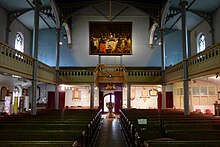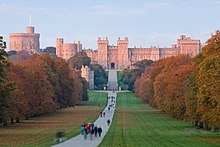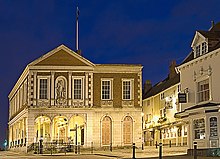Windsor, Berkshire
| Windsor | |
 Windsor Bridge, Windsor and Windsor Castle |
|
|
| |
| Population | 26,885 (2001) |
|---|---|
| OS grid reference | SU965765 |
| Unitary authority | Windsor and Maidenhead |
| Ceremonial county | Berkshire |
| Region | South East |
| Country | England |
| Sovereign state | United Kingdom |
| Post town | WINDSOR |
| Postcode district | SL4 |
| Dialling code | 01753 |
| Police | Thames Valley |
| Fire | Royal Berkshire |
| Ambulance | South Central |
| EU Parliament | South East England |
| UK Parliament | Windsor |
The town is situated 21 miles (34 km) west of Charing Cross, London. It is immediately south of the River Thames, which forms its boundary with Eton. The village of Old Windsor, just over 2 miles (3 km) to the south, predates what is now called Windsor by around 300 years; in the past Windsor was formally referred to as New Windsor to distinguish the two.[1]
Contents
History
Windsor is first mentioned in the Anglo-Saxon Chronicle. The name originates from old English Windles-ore, or 'winch by the riverside',[3][4] a royal settlement, now called Old Windsor, located about 3 miles (5 km) from the modern town. Windsor Castle was originally built by William the Conqueror in the decade after the Norman conquest of 1066,[5] a timber motte and bailey structure in the manor of Clewer. It was noted in the Domesday Book as 'Windsor Castle'. Some time after 1086, probably in the reign of King Henry I, the royal household moved upstream to the recently built castle. By 1110, important crown wearings (Great Council of state) were noted as taking place at the castle and King Henry married his second wife there in 1121, after the 'White Ship' disaster. The settlement at Old Windsor largely transferred to this 'New' Windsor during the 12th century, although substantial planning and setting out of the new town (including the parish church, marketplace, bridge and leper hospital) did not take place until c. 1170, following the civil war of Stephen's reign. At about the same time, the present upper ward of the castle was rebuilt in stone. Windsor Bridge is the earliest bridge on the Thames between Staines and Reading, having been built when bridge building was not common. It played an important part in the national road system, linking London with Reading and Winchester, but also by diverting traffic into the new town, underpinned its success.
The town of New Windsor, as an ancient demesne of the Crown, was a privileged settlement from the start, apparently having the rights of a 'free borough' for which other towns had to pay substantial fees to the king. It had a merchant guild (known by the 14th century as the Fraternity or brotherhood of the Trinity) from the early 13th century and, under royal patronage, was made the chief town of the county later in the same century. Windsor was granted royal borough status by Edward I's charter in 1277. This gave no new rights or privileges to Windsor but, as one historian puts it, "recognised [Windsor's] existence and gave it a legal status as a borough".[2] Importantly, as a self-governing town, it maintained a 'common cheest' paying for improvements to the town from its own resources. The town accounts of the 16th century survive, although most of the once substantial borough archive was destroyed, probably in the late 17th century.

The Last Supper by Franz de Cleyn in the West Gallery of Windsor parish church of St John The Baptist.[6]
The development of the castle continued in the 15th century. Windsor became a major pilgrimage destination, particularly for Londoners. Pilgrims came to touch the royal shrine of the murdered Henry VI and the fragment of the True Cross in the new St George's Chapel (1480) and to visit the same king's college at Eton (Eton College), which was dedicated in 1440 to the Blessed Virgin Mary. Pilgrims came with substantial sums to spend. There were over 29 inns in Windsor to provide accommodation, some very large. The town became very prosperous. For London pilgrims, Windsor was probably second in importance only to Canterbury and the shrine of Saint Thomas Becket. Henry VIII was buried in St George's Chapel in 1547, next to the body of Jane Seymour, the mother of his only legitimate son, Edward (Edward VI). Henry, the founder of the Church of England, may have wanted to benefit from the stream of Catholic pilgrims coming to the town. His will gives that impression.
Tudor and Stuart periods
The town began to stagnate about ten years after the Reformation. The castle was considered old fashioned and shrines to the dead were thought to be 'superstitious'. The early modern period formed a stark contrast to the medieval history of the town. Most accounts of Windsor in the 16th and 17th centuries talk of its poverty, badly made streets and poor housing. Shakespeare's play The Merry Wives of Windsor is set in Windsor and contains many references to parts of the town and the surrounding countryside. Shakespeare must have walked the town's streets, near the castle and river, much as people still do. The play may have been written in the Garter Inn, although this was certainly not part of the modern Harte and Garter Hotel opposite the castle. Nell Gwyn's house, Burford House, is located on Church Street and was built in 1640. A tunnel, long since gone, is reported to have been built from this house to the inside of the castle.Windsor was the home of the New Model Army and the castle was garrisoned by Colonel Venn during the English Civil War. Despite its royal dependence, like many commercial centres, Windsor was a Parliamentarian town. Charles I was buried without ceremony in St George's after his execution at Whitehall in 1649. The present Guildhall, built in 1680, replaced an earlier market hall that had been built on the same site around 1580, as well as the old guildhall, which faced the castle and had been built around 1370. The contraction in the number of public buildings speaks of a town in decline. In 1652 the largest house in Windsor Great Park was builit on land which Oliver Cromwell had appropriated from the Crown. Now known as Cumberland Lodge after the Duke of Cumberland's residence there in the mid 18th century, the house was variously known as Byfield House, New Lodge, Ranger's Lodge, Windsor Lodge and Great Lodge.[7]
Georgian and Victorian periods
Later periods
Most of the current town's streets date from the mid to late 19th century.[8] However the main street, Peascod Street (pronounced Pes-cod Street) is very ancient, predating the castle by many years. It formed part of the 10th-century parish structure in east Berkshire[citation needed] and in comparison, the 1000 year old royal castle, although the largest and longest occupied in Europe, is a recent development. "New Windsor" was officially renamed "Windsor" in 1974.Shopping
Windsor is particularly well served when it comes to shops. As a tourist town there is a wide selection of gift shops around the castle, together with stylish shops and restaurants in Windsor Royal Station. The main shopping street, Peascod Street, includes as an independent department store, W J Daniel & Co, noted for its large toy department, as well as national chains such as Marks & Spencer and Boots. King Edward Court, a pedestrian-only shopping centre, has a Waitrose supermarket alongside other stores including H&M, New Look and Zara.Tourism
Regular return riverboat cruises operate daily from February to November from the Promenade, Barry Avenue. These include forty-minute and two-hour trips and provide unique views of the castle.
In winter, Alexandra Gardens hosts a temporary ice rink.[9]
Transport
Windsor is accessible from Junction 6 of the M4 and Slough via a 3-mile long dual-carriageway. Bus services in the town are mostly provided by First Berkshire & The Thames Valley, although a park-and-ride service and one local route are operated by Courtney Coaches.Windsor has two railway stations. Windsor & Eton Central railway station has a shuttle service to Slough which has access to trains into London Paddington, and west to Maidenhead, Reading and as far as Bristol. Windsor & Eton Riverside station provides a service to London Waterloo. Both stations were built at around the same time in the 19th century, as the two train companies which owned the lines both wanted to carry Queen Victoria to Windsor, with the first line opened gaining the privilege. From 1883 to 1885, the London Underground's District Line's westbound service ran as far as Windsor.
Windsor is linked to the town of Eton (which is situated on the opposite bank of the River Thames) by Windsor Bridge. Originally a fully trafficked road bridge, Windsor Bridge is now for pedestrians and cyclists only and provides an excellent walking route from Windsor to Eton's High Street. To the south of the town lies Windsor Great Park and the towns of Old Windsor, Egham and Virginia Water.
Windsor lies on National Cycle Route 4 (London – St David's). The main access roads serving the town have adjacent cycle paths or nearby alternative traffic-free cycle routes.
Notable residents
Other than HM Queen Elizabeth II and other British Royal Family members, Windsor has many notable residents both former and current.- Actress Anna Friel spent several years living in Windsor, but moved away in 2007
- Australian pop singer Natalie Imbruglia owns a house on White Lilies Island in the Clewer village area of Windsor but does not currently live there.
- Actor Michael Caine lived at the Old Mill House at the end of Mill Lane, Windsor during the 1960s and '70s. The house was subsequently sold to guitarist Jimmy Page of the rock band Led Zeppelin, who sold the property in 2004.
- Actor Kris Marshall used to live in the Clewer area from 2000 to 2009.
- Dhani Harrison- English musician, son of George Harrison, was born in Windsor.
- Comedian Freddie Starr – Lived in Windsor in the 1970s in the St Leonard's Hill area.
- Ian Lucas - drummer with Everwhile and General Manager of Windsor FC.
- Pop Star Lisa Scott-Lee – Formerly of the teen band Steps and now a solo performer.
- Margaret Oliphant – 19th century novelist and historical writer; lived at Clarence Crescent. Today the house is named "Oliphant House".
- Ranulph Fiennes – Adventurer, explorer and author was born in Windsor.
- Actress Sue Holderness – Played Marlene in the long running UK TV sit-com Only Fools and Horses and in The Green Green Grass.
- Sir Sydney Camm – Inventor of the World War II fighter aircraft the Hawker Hurricane lived at 10 Alma Road.
- Zinzan Brooke – New Zealand rugby union international, who formerly played amateur rugby for Windsor Rugby Football Club. A current Windsor resident.
- Hugh Thomas – historian, was born in Windsor.
- Michael Corby - Musician founder of The Babys rock band was born in Windsor, in 1951.
Sport
Windsor's senior football team is Windsor F.C.. The team currently plays in the Combined Counties League Premier Division and their home is Stag Meadow, granted to the original club by King George VI in 1911. The ground, in Windsor Great Park, is one of the most iconic football locations in the UK. The club's president is the famous BBC commentator Barry Davies.Windsor Cricket Club's clubhouse and pitches are at Home Park in the shadow of Windsor Castle. The club played host to the 2006 Lord's Taverners cricket match. The Windsor 1st team currently play in Division 2A of the Thames Valley League. The Club Captain is Chris Smith.
Neighbours, Windsor Rugby Club also use the ground and the team currently plays in the Southern Counties – South Division.
Several other local sports clubs are based at Home Park, including: Hockey and archery clubs, and the Datchet Dashers running club.
Royal Windsor Rollergirls, were one of the first roller derby leagues to be founded in the UK in 2007, they regularly hold games at Windsor Leisure Centre.
Politics
For more details on this topic, see Windsor (UK Parliament constituency).
Windsor is part of the Royal Borough of Windsor and Maidenhead which is administered by an elected unitary authority. The mayor is Cllr Andrew Jenner (Conservative).The current Member of Parliament for the Windsor constituency (which includes surrounding small towns and villages, such as Eton and Datchet) is Adam Afriyie (Conservative), who was elected at the 2005 General Election. Afriyie is notable for being the first black Conservative in the House of Commons.
In 2012 the council reintroduced the role of town crier to the Borough. The previous town crier had retired in 1892 and for 110 years the post remained vacant. The new town crier is Chris Brown.[10










Ei kommentteja:
Lähetä kommentti